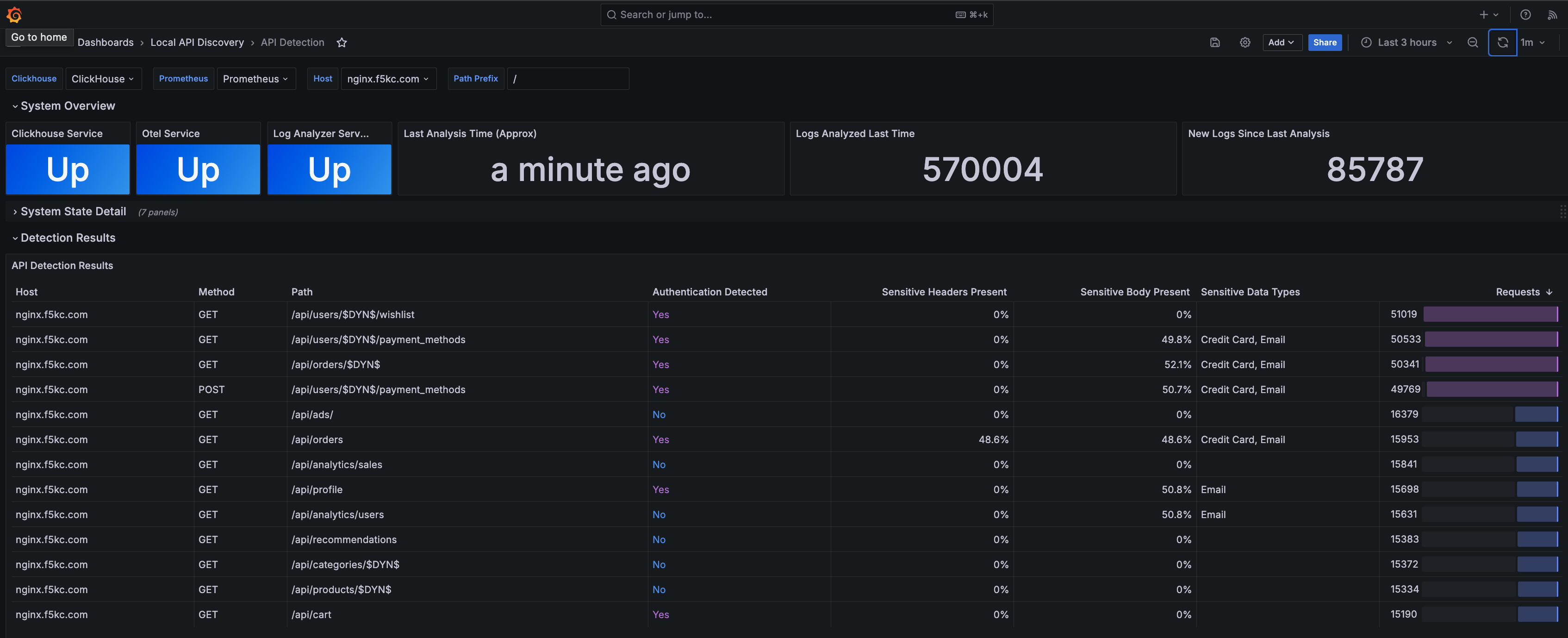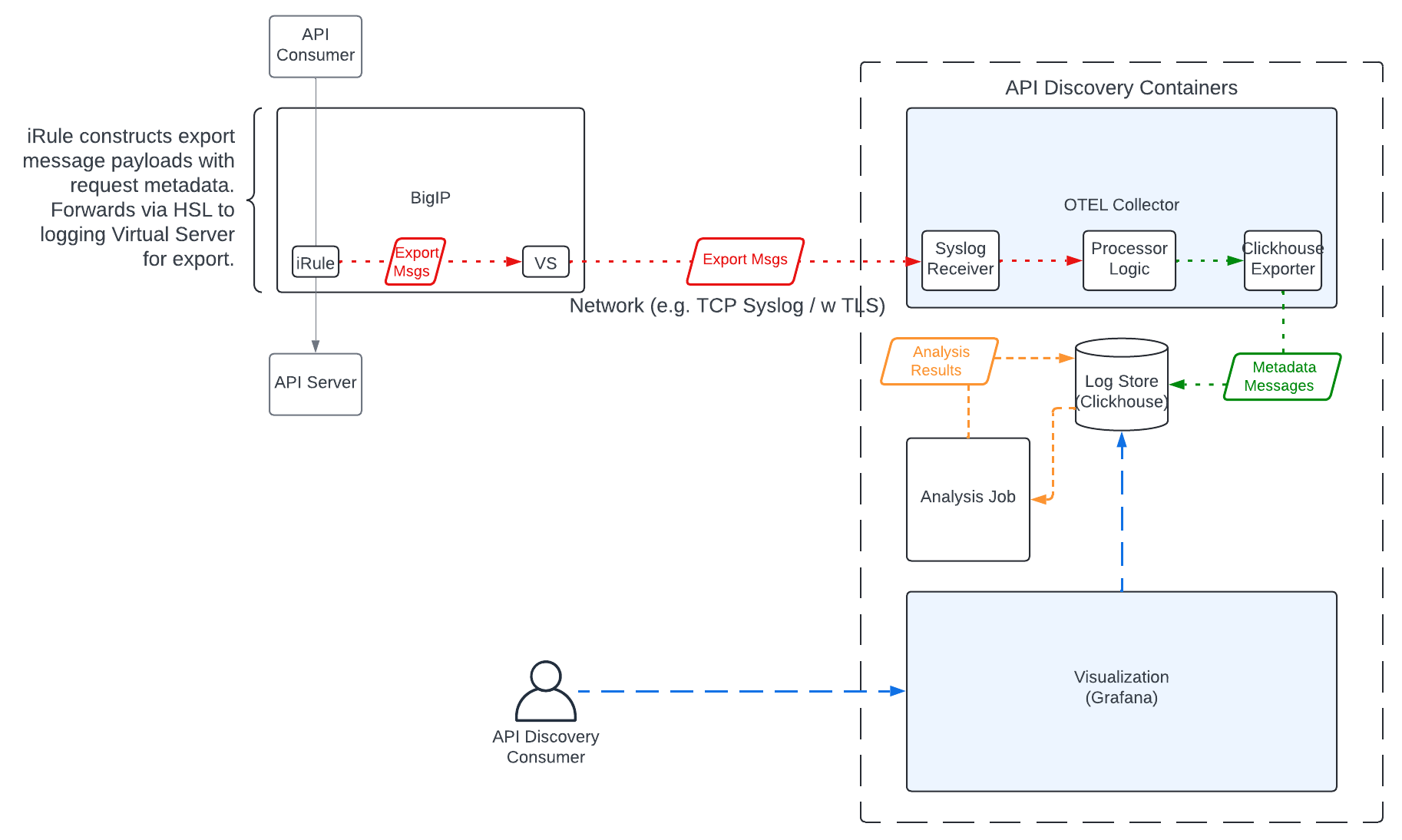F5 Application Study Tool Labs > Class 1: Introduction to F5 Application Study Tool > Module 4: Exploring the F5 Local API Discovery Tool Source | Edit on
F5 LADT Overview¶
In this lab, we’ll run through an overview of the F5 Local API Discovery Tool. At a high level, the F5 LADT is:
The AST Local API Discovery Tool (LADT) is a fork of the Application Study Tool focused on analyzing data about customer APIs based on data from classic F5 BIG-IP logs.
The LADT receives per-http-request data from F5 BIG-IP devices and stores relevant fields for periodic batch analysis. Output of the analysis is a list of likely API endpoints, whether or not they are authenticated, and the number of requests processed by each endpoint. API detection logic is based on a subset of official F5 product offerings, with some advanced functionality (e.g. schema discovery and Machine Learning analysis) excluded for performance reasons.
Example API Detection Output¶

System Overview¶
The F5 LADT relies on a specially-crafted iRule to export per-request metadata to the analysis system, running on-prem. The analysis system consists of:
Opentelemetry Collector: For receiving incoming logs, processing, and forwarding them to storage system
ClickHouse Database: For storing log data and running analysis queries
Analysis Job: Runs periodically to generate results
Grafana: For visualizing results, and system component states

System Prerequisites and Recommendations¶
Linux system with docker (or compatible) - Installation Instructions
F5 BIG-IP with logging iRule (contact your F5 Team for access)
Network connectivity (default TCP port 6514) between the BigIP and instance running LADT
Minimal system specs for running the Local API Discovery Tool will depend heavily on expected traffic load.
The following performance characteristics were observed with an Intel(R) Xeon(R) Gold 6138 CPU @ 2.00GHz running localized testing (single TCP+TLS connection meant to simulate a stream of data from a single BigIP Device). Actual message throughput under real world network conditions would likely be quite a bit lower.
Msg/Sec |
Collector CPU Util |
Clickhouse CPU Util |
Collector Mem Util |
Clickhouse Mem Util |
|---|---|---|---|---|
0 |
0.5% |
0.8% |
40MiB |
546MiB |
1 |
0.7% |
1.3% |
41.5MiB |
629MiB |
10 |
0.8% |
1.6% |
58MiB |
629MiB |
100 |
1.7% |
1.8% |
66MiB |
646MiB |
1000 |
8% |
2.8% |
115MiB |
650MiB |
10000 |
59.3% |
40% |
176MiB |
698MiB |
20000 |
133% |
44% |
216MiB |
750MiB |
30000 |
180% |
47% |
216MiB |
798MiB |
40000 |
235% |
70% |
225MiB |
948MiB |
54000 |
298% |
106% |
245MiB |
1000MiB |
The analysis script adds an additional ~10% CPU and 250MiB of load to the clickhouse instance while performing analysis.
Analyzed Messages |
Analysis Duration Sec |
|---|---|
1000 |
113ms |
10000 |
0.9s |
10000 |
6.67s |
20000 |
14.7s |
1.04M |
1.12min |
2.2M |
2.51min |
10M |
4.06min |
Disk space usage likewise depends on volume, but clickhouse provides a good amount of compression (here 758 million entries are stored in ~210MiB).
Rows |
Disk Size |
Bytes Size |
Compressed Size |
Uncompressed Size |
Ratio |
|---|---|---|---|---|---|
758799480 |
210.24MiB |
220452423 |
209.25 MiB |
21.16 GiB |
0.00965486284484136 |
Note
As previously mentioned, we won’t get digging into the installation details or process within this lab module.
If you’re interested in going down that path and learning more, please visit the F5 LADT GitHub Repo’s Installation section
Select Next below for to learn how to access the F5 LADT Grafana instance in the UDF lab environment.